Reverse Genetic Assessment of the Roles Played by the Spike Protein and ORF3 in Porcine Epidemic Diarrhea Virus Pathogenicity
- PMID: 37358450
- PMCID: PMC10373562
- DOI: 10.1128/jvi.01964-22
Reverse Genetic Assessment of the Roles Played by the Spike Protein and ORF3 in Porcine Epidemic Diarrhea Virus Pathogenicity
Abstract
Porcine epidemic diarrhea virus is a swine pathogen that has been responsible for significant animal and economic losses worldwide in recent years. In this manuscript, we report the generation of a reverse genetics system C(RGS) for the highly virulent US PEDV strain Minnesota (PEDV-MN; GenBank accession number KF468752), which was based on the assembly and cloning of synthetic DNA, using vaccinia virus as a cloning vector. Viral rescue was only possible following the substitution of 2 nucleotides within the 5'UTR and 2 additional nucleotides within the spike gene, based on the sequence of the cell culture-adapted strains. Besides displaying a highly pathogenic phenotype in newborn piglets, in comparison with the parental virus, the rescued recombinant PEDV-MN was used to confirm that the PEDV spike gene has an important role in PEDV virulence and that the impact of an intact PEDV ORF3 on viral pathogenicity is modest. Moreover, a chimeric virus with a TGEV spike gene in the PEDV backbone generated with RGS was able to replicate efficiently in vivo and could be readily transmitted between piglets. Although this chimeric virus did not cause severe disease upon the initial infection of piglets, there was evidence of increasing pathogenicity upon transmission to contact piglets. The RGS described in this study constitutes a powerful tool with which to study PEDV pathogenesis and can be used to generate vaccines against porcine enteric coronaviruses. IMPORTANCE PEDV is a swine pathogen that is responsible for significant animal and economic losses worldwide. Highly pathogenic variants can lead to a mortality rate of up to 100% in newborn piglets. The generation of a reverse genetics system for a highly virulent PEDV strain originating from the United States is an important step in phenotypically characterizing PEDV. The synthetic PEDV mirrored the authentic isolate and displayed a highly pathogenic phenotype in newborn piglets. With this system, it was possible to characterize potential viral virulence factors. Our data revealed that an accessory gene (ORF3) has a limited impact on pathogenicity. However, as it is also now known for many coronaviruses, the PEDV spike gene is one of the main determinants of pathogenicity. Finally, we show that the spike gene of another porcine coronavirus, namely, TGEV, can be accommodated in the PEDV genome background, suggesting that similar viruses can emerge in the field via recombination.
Keywords: ORF3; porcine epidemic diarrhea virus; spike gene; synthesized DNA; vaccinia virus reverse genetics.
Conflict of interest statement
The authors declare no conflict of interest.
Figures
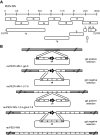

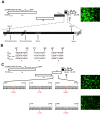
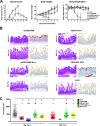

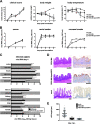

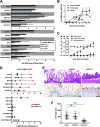
Similar articles
-
Spike gene variability in porcine epidemic diarrhea virus as a determinant for virulence.J Virol. 2025 Mar 18;99(3):e0216524. doi: 10.1128/jvi.02165-24. Epub 2025 Feb 26. J Virol. 2025. PMID: 40001283 Free PMC article.
-
Deletion of a 197-Amino-Acid Region in the N-Terminal Domain of Spike Protein Attenuates Porcine Epidemic Diarrhea Virus in Piglets.J Virol. 2017 Jun 26;91(14):e00227-17. doi: 10.1128/JVI.00227-17. Print 2017 Jul 15. J Virol. 2017. PMID: 28490591 Free PMC article.
-
Characterization of a Pathogenic Full-Length cDNA Clone and Transmission Model for Porcine Epidemic Diarrhea Virus Strain PC22A.mBio. 2016 Jan 5;7(1):e01451-15. doi: 10.1128/mBio.01451-15. mBio. 2016. PMID: 26733065 Free PMC article.
-
[Advances in reverse genetics to treat porcine epidemic diarrhea virus].Sheng Wu Gong Cheng Xue Bao. 2017 Feb 25;33(2):205-216. doi: 10.13345/j.cjb.160282. Sheng Wu Gong Cheng Xue Bao. 2017. PMID: 28956377 Review. Chinese.
-
Deciphering the biology of porcine epidemic diarrhea virus in the era of reverse genetics.Virus Res. 2016 Dec 2;226:152-171. doi: 10.1016/j.virusres.2016.05.003. Epub 2016 May 20. Virus Res. 2016. PMID: 27212685 Free PMC article. Review.
Cited by
-
Reverse Genetics Systems for Emerging and Re-Emerging Swine Coronaviruses and Applications.Viruses. 2023 Sep 26;15(10):2003. doi: 10.3390/v15102003. Viruses. 2023. PMID: 37896780 Free PMC article. Review.
-
Safety and efficacy of live attenuated PEDV vaccines for neonatal protection.NPJ Vaccines. 2025 Jun 23;10(1):131. doi: 10.1038/s41541-025-01195-w. NPJ Vaccines. 2025. PMID: 40550792 Free PMC article.
-
Epidemiological monitoring and genetic variation analysis of pathogens associated with porcine viral diarrhea in southern China from 2021 to 2023.Front Microbiol. 2024 Mar 20;15:1303915. doi: 10.3389/fmicb.2024.1303915. eCollection 2024. Front Microbiol. 2024. PMID: 38572229 Free PMC article.
-
Development of a safe and broad-spectrum attenuated PEDV vaccine candidate by S2 subunit replacement.J Virol. 2024 Nov 19;98(11):e0042924. doi: 10.1128/jvi.00429-24. Epub 2024 Oct 15. J Virol. 2024. PMID: 39404450 Free PMC article.
-
Spike gene variability in porcine epidemic diarrhea virus as a determinant for virulence.J Virol. 2025 Mar 18;99(3):e0216524. doi: 10.1128/jvi.02165-24. Epub 2025 Feb 26. J Virol. 2025. PMID: 40001283 Free PMC article.
References
-
- Stevenson GW, Hoang H, Schwartz KJ, Burrough ER, Sun D, Madson D, Cooper VL, Pillatzki A, Gauger P, Schmitt BJ, Koster LG, Killian ML, Yoon KJ. 2013. Emergence of porcine epidemic diarrhea virus in the United States: clinical signs, lesions, and viral genomic sequences. J Vet Diagn Invest 25:649–654. doi:10.1177/1040638713501675. - DOI - PubMed
-
- De Groot R, Baker SC, Baric R, Enjuanes L, Gorbalenya AE, Holmes KV, Perlman S, Poon LL, Rottier P, Talbot PJ, Woo PC, Ziebuhr J. 2012. Family Coronaviridae. p 806–828. In King AMQ, Carstens EB, Lefkowitz EJ (ed), Virus taxonomy: Ninth Report of the International Committee on Taxonomy of Viruses. Elsevier Academic Press, Amsterdam, NL.
Publication types
MeSH terms
Substances
LinkOut - more resources
Full Text Sources

